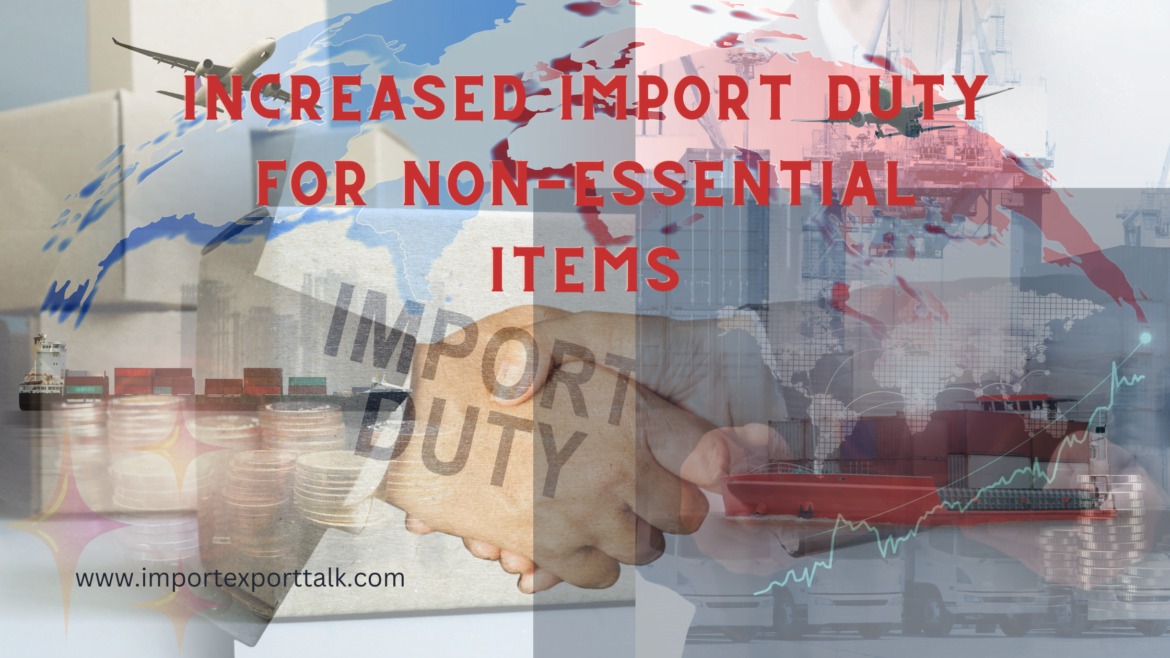In recent years, India has the implementation of increased import duty for non-essential items to adopted various economic measures to bolster domestic industries, reduce the trade deficit, and promote self-reliance. This step aimed to encourage local manufacturing, protect domestic industries, and align with the “Make in India” initiative. We will explore the significance of India’s increased import duty on non-essential items, the reasons behind its implementation, its impact on the economy and consumers, and the challenges it faced.
What are non-essential items?
Non-essential items are those that are not considered to be necessary for daily life. They include items such as luxury goods, electronics, and clothing.
Understanding the Rationale behind Increased Import Duty
The rationale behind India’s increased import duty on non-essential items was primarily twofold. Firstly, it aimed to address the persistent trade deficit by curbing excessive imports. Secondly, the move intended to promote and protect domestic industries, fostering economic growth and reducing the country’s dependency on foreign goods. This is because these industries are often unable to compete with foreign companies that produce the same goods at a lower cost. By increasing import duties, the government hopes to make it more expensive for foreign companies to import their goods into India, which will give domestic industries a better chance to compete.
Promoting Economic Growth and Self-Reliance through “Make in India”
India’s “Make in India” initiative focused on transforming the nation into a global manufacturing hub and promoting domestic production. Increased import duty played a crucial role in supporting this initiative by making foreign-made non-essential items more expensive, encouraging consumers to opt for domestically manufactured alternatives.
Implications of Increased Import Duty on Consumers
While increased import duty had positive implications for domestic industries, consumers faced challenges due to the rise in prices of non-essential items. This led to potential reductions in consumer spending power and demand, impacting various segments of the population.
What are the tariff measures that the government is implementing?
The government is implementing a number of tariff measures, including:
- Increased import duties: The import duty on a number of non-essential items will be increased. For example, the import duty on mobile phones will be increased from 20% to 25%.
- Increased customs clearance fees: The customs clearance fees on a number of non-essential items will also be increased. This will make it more expensive for businesses to import these goods into India.
- Increased restrictions on imports: The government is also increasing restrictions on imports of non-essential items. This means that businesses will need to obtain a license from the government before they can import these goods.
Positive Impact on Domestic Industries
The higher import duty created a level playing field for domestic manufacturers, allowing them to compete more effectively with foreign products. This measure boosted domestic demand, encouraged investments in local industries, and fostered employment opportunities.
Striving for Economic Self-Reliance
The concept of economic self-reliance, or “Atmanirbhar Bharat,” aimed to reduce India’s reliance on imports and enhance the nation’s economic independence. Increased import duty aligned with this goal by channeling resources and demand towards domestic production.
Challenges and Criticisms
Despite its intentions, the increased import duty faced certain challenges and criticisms. These included the potential rise of smuggling, reduced consumer affordability, inflationary pressures, trade disputes with trading partners, and disruptions in global supply chains.
Mitigating Challenges and Striking a Balance
To address these challenges and criticisms, the Indian government needed to adopt a balanced approach. This approach included focusing on research and development, fostering innovation, addressing consumer concerns, and engaging in diplomatic trade negotiations.
The Impact on Trade Relations and Diplomacy
While the increased import duty was intended to protect domestic industries, it also had implications for India’s trade relations with other countries. Some trading partners perceived these measures as protectionist and responded with similar trade barriers on Indian exports. This led to potential trade disputes and strained diplomatic relationships, affecting overall international trade.
The Role of Research and Development
To make the most of increased import duty and promote domestic industries, investment in research and development (R&D) was crucial. By encouraging R&D, the Indian government aimed to enhance the quality, efficiency, and competitiveness of domestic products, allowing them to match or even exceed the standards of imported goods.
Encouraging Innovation and Entrepreneurship
The higher import duty encouraged innovation and entrepreneurship in India. Domestic manufacturers were incentivized to find new and more efficient ways of producing non-essential items to meet consumer demand. This resulted in the emergence of innovative startups and enterprises, contributing to job creation and economic growth.
Balancing Import Duty with Consumer Welfare
To strike a balance between promoting domestic industries and ensuring consumer welfare, the Indian government needed to carefully assess the impact of increased import duty on consumers. Policymakers aimed to find ways to minimize the burden on consumers by focusing on essential items and exempting them from higher import duties.
Collaboration with Trading Partners
To mitigate potential trade disputes and maintain healthy international trade relations, India sought to collaborate and engage in dialogues with its trading partners. Diplomatic efforts were made to address concerns and ensure that increased import duties did not lead to unfair trade practices or retaliation from other countries.
Monitoring and Evaluating the Impact
Continuous monitoring and evaluation of the impact of increased import duty were essential to understand its effectiveness and make necessary adjustments. The government needed to assess the outcomes on domestic industries, consumers, trade balance, and overall economic growth.
Long-Term Economic Growth and Self-Reliance
The success of India’s increased import duty on non-essential items relied on its ability to contribute to long-term economic growth and self-reliance. This required a holistic approach, incorporating trade policies, domestic industry support, and consumer welfare considerations.
India’s decision to implement increased import duty on non-essential items was a significant step towards fostering domestic industries, promoting self-reliance, and addressing the trade deficit. While this measure had positive implications for the economy, it also faced challenges, including potential trade disputes and reduced consumer affordability.
By adopting a well-balanced approach, focusing on research and development, fostering innovation and entrepreneurship, and engaging in collaborative efforts with trading partners, India could maximize the benefits of increased import duty. Continuous monitoring and evaluation would enable policymakers to fine-tune the measures, ensuring sustained economic growth and progress towards self-reliance.
As India continued its journey towards economic prosperity, the role of increased import duty would remain a crucial aspect of its trade policy, supporting the “Make in India” initiative and strengthening domestic industries for a brighter and more self-sufficient future.

